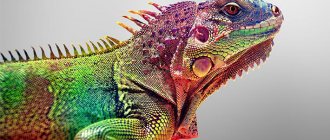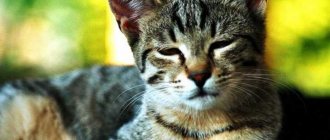Many owners of four-legged animals do not think about whether it is possible to give sweets to cats. They notice the pets’ strong craving for treats and observe with what pleasure the kittens chew candy or various cookies, they lick pastries, ice cream and cakes. However, do not forget that sweets are contraindicated for kittens and older pets. These products can cause serious harm to the animal's health. If you constantly feed your pet foods containing sugar, you may lose your pet forever.
Physiology of taste in cats
When a cat receives a piece of chocolate or caramel or ice cream from the owner’s hands, it, at first glance, eats the sweets with pleasure. In fact, she is attracted to the fats and dairy products found in treats. But the taste itself remains uncertain for the pet; it does not feel it and does not receive the pleasure characteristic of a person.
The reason for this phenomenon is explained by the absence of the Tas 1r2 gene in cats. It is its content in the blood of mammals that is responsible for the craving for sweets.
For cats, animal proteins, found in large quantities in meat, are a treat, and sugar and all its derivatives are just a by-product found in ice cream and chocolate.
A cat can recognize any protein with amazing ease. It is noteworthy that wild feline predators are able to determine by smell whether the prey they hunt is alive, injured, or already dead.
And since cats are not able to recognize sugar, they do not feel and do not control the amount of its consumption. Therefore, they can easily exceed the safe dose, which is actually very low. There is only one way out - do not give sweets to cats at all.
If in tiny quantities sweets are simply useless for cats, then at the slightest excess of the norm it becomes very dangerous.
Favorite but harmful treats
Some of the sweet preferences of cats include chocolate, ice cream and sucking candies (on a stick, caramels). Most owners admit that they can sometimes give their cats sweets, but very little, as a treat. The difficulty is that sweets do not cause immediate harm, that is, the cat does not feel ill immediately after eating a piece of ice cream. The period of time and gradual development of most pathologies leads to the fact that the owner does not connect the pet’s illness and the fact of eating sweets.
Any experienced owner and veterinarian will tell you that giving them chocolate is a big mistake. Real chocolate is poison for cats and dogs. For poisoning, which leads to liver failure, a large dog needs to eat a chocolate bar (100 grams), while a cat needs 30–40 grams. Naturally, we are not talking about a surrogate treat, but about real chocolate, which contains cocoa and caffeine. Natural chocolate contains methylxanthine (an alkaloid), which (in sufficient quantities) literally stops the liver. However, you shouldn’t expect any benefits for your pet’s health from fake chocolate.
Warnings about the dangers of chocolate are based not only on experience, but also on research. Veterinarians monitored the dynamics of poisoning and the rate of its progression. Anamnesis collection and autopsy testimony allowed us to draw clear conclusions - the animals died from chocolate poisoning. By the way, the mechanism of poisoning and the dose of the deadly delicacy could not be clarified. Veterinarians have accepted it as fact that chocolate is toxic to small pets.
Even special chocolate treats sold in pet stores are not as harmless as they say on the packaging. As mentioned above, there is no point in such treats, because cats cannot like sweets due to the fact that they do not feel this taste.
The favorite treat of adults, children and cats is ice cream. It would seem that a dairy product should not be harmful, but everything is not so simple. Firstly, there is sugar in ice cream, and secondly, the store-bought product hardly contains milk. Even if we take ice cream as an example, which was once produced according to GOST, it contained cream and butter - extremely harmful products for a cat’s liver. A cat that has received too much sugar suffers from intoxication, in other words, from poisoning.
Another favorite treat is condensed milk. The logic of the owners is similar, although the milk may be sweet, it means it cannot be harmful. The warnings are the same: condensed milk contains a lot of sugar, and the store-bought product includes preservatives, flavors, unnatural sweeteners and exclusively powdered milk. The cat does not feel the sweet taste, powdered milk is not beneficial, so is there any point in treating it with such a treat?
What could be healthier than fermented milk products for cats who love milk? Every guide to feeding four-legged animals recommends diluting the cat’s diet with yogurt, kefir, fermented baked milk, etc. However, not every guide specifies that the products must be natural and not store-bought. Only in this case can we talk about real benefits. Any fermented milk products with sweeteners are harmful, which means store-bought yogurt should be excluded from your pet’s diet. Moreover, the cat may not benefit from natural fermented milk products, since some adult animals do not digest milk sugar.
When consuming store-bought dairy products with sweeteners, a cat may suffer from chronic conjunctivitis, and this is not a coincidence. Many owners didn't know how to eliminate bad odor from their cat's ears, and it can also be caused by eating sugar.
The owners of sweet dogs can only wish patience in re-educating their charges. Try to balance the diet, take a vitamin course and gradually wean your cat off sugar. If your nervous system cannot withstand the onslaught of pleading eyes, offer your cat a piece of dried apricots (no raisins) or peanuts. These products are not healthy for the cat and contain a lot of carbohydrates, but are safer than sugar.
Another safe alternative is special treats (sweet) for animals, which are sold at the pet store. However, be careful, many owners have weaned cats from eating sugar in favor of treats, but they cannot exclude them from the diet
It is important that any additives to the main diet are strictly rationed
What is the harm of sweets for a cat?
The most dangerous sweet for cats is chocolate. The content of the alkaloid theobromine in cocoa beans is very high. When it enters the cat's body in small doses, a jump in blood pressure occurs, the animal develops tachycardia, and abnormal agitation appears.
If a cat consumes chocolate excessively, poisoning quickly occurs, which most often ends in death. Since the animal’s kidneys and liver accumulate this alkaloid, but are not capable of decomposing it and removing it from the body. But any product containing sugar is no less harmful to the cat. The carbohydrate content in it is very high; the cat has no need for such concentrations in the blood.
The carbohydrate that an animal receives from dry food or natural healthy food is quite sufficient for the normal functioning of the body. And the excess is deposited in the form of fat reserves - subcutaneous and, what is much worse, on the walls of internal organs, which leads to obesity of the liver, kidneys, and other body systems.
It is especially dangerous to give sweets to young animals, elderly pets, pregnant and lactating females, and animals with chronic diseases.
In old animals, sweets will sharply increase the fragility of blood vessels. And eating chocolate by pregnant cats can lead to miscarriages, the development of fetal pathologies and the birth of stillborn kittens.
Signs of chocolate poisoning
The first manifestations that may indicate that the cat has eaten a large amount of cocoa product:
- fear, anxiety, nervousness (in some cases the animal shows aggression);
- strong thirst;
- diarrhea, frequent urination;
- nausea, vomiting;
- tremor, convulsions, convulsions;
- arrhythmia, rapid breathing;
- lethargy (more often after hyperactivity)
As first aid, the cat should be given a sorbent, after which it should be shown to a veterinarian. After poisoning, the pet should be kept on a gentle diet and sugar should be completely eliminated from the diet.
Sweets and cat diseases
The first thing that can happen to a pet when eating sweets is a decrease in immunity and the development of many serious diseases.
Immune defense disorders
Even a small piece of chocolate can cause severe poisoning in a cat. And if everything seems to have gone well, the consequences may be distant.
The immune system was damaged in any case. And against the background of this disorder, allergic reactions may occur, diseases of the oral cavity may appear, numerous redness, ulcers and sores form on the gums, itching of the skin, hair loss begins and the development of alopenia.
Chocolate, sweets, and cakes can also cause a deterioration in a cat’s vision, including blindness, as well as cause diarrhea and vomiting, and increased salivation.
Decreased immunity undermines the cat's body's defenses. The animal becomes susceptible to colds and viral diseases, otitis media and conjunctivitis, fungal infections of any organs.
The digestive system also suffers, the animal develops a false feeling of fullness, and the digestibility of animal protein deteriorates. Oxygen saturation of tissues decreases, and the aging process of the entire organism as a whole accelerates.
Urolithiasis disease
Cats' kidneys are the first to suffer when they eat sweets. Due to intensive work (after all, this is a purification system that unsuccessfully tries to remove harmful products from the body), they significantly increase in size.
The animal's organs are subject to wear and tear, and the acid-base balance is disturbed. And sweets can lead to this just as much as salty foods.
Depending on the type of sweets, either excessive oxidation or alkalization of the body occurs, which in any case leads to the development of kidney failure. Urolithiasis, when eating sweets in large quantities, occurs even in cats that do not have a predisposition to it.
Diabetes
A cat's body is not designed to process large amounts of glucose. Insulin begins to be produced in concentrations that greatly exceed the permissible norm in the blood.
The cat quickly loses sensitivity to this substance, the level of glucose in both the blood and the animal’s urine always remains at high levels, diabetes mellitus quickly develops and the pet becomes a hostage to the “sugar” diet.
Excess carbohydrates
A person often eats a piece of chocolate when he needs to quickly increase energy levels, relieve fatigue, improve the ability to think and make decisions instantly, during heavy mental or physical work. And after even a small dose of chocolate, you feel a surge of strength and acceleration of thought.
By offering the same piece of treat to a pet, the owner causes him great harm. Especially for a cat in a small apartment, where she does not have the opportunity to move enough. All excess carbohydrates, even if they do not lead to serious illnesses, will certainly be stored in the form of excess fat.
Nature provides for the consumption of large quantities of proteins by predators, which is the key to their health and longevity. Carbohydrates are needed in minimal quantities; exceeding the required level means dooming your pet to illness and early death.
Lack of control
As you know, one cookie or candy will not bring big trouble.
This rule is true for us, as well as for our pets. But it is precisely this point that causes controversy. “Is it possible to give sweets to cats in small quantities?” – owners ask almost every time at a veterinarian’s appointment. It’s best not to give at all, because you are creating incorrect eating behavior, and your furry pet will ask for something that is dangerous for it. During the tasting process, the pet does not recognize sugar and may eat a large portion, unable to control the permissible dosage of the harmful substance. As a result, food poisoning, an allergic reaction and other adverse consequences for the predator may develop.
When does a cat need sugar?
But still, in some cases, the pet needs additional sugar. They are very rare and are the consequences of serious illness or recovery in the postoperative period. And only when the level of glucose in the blood is much lower than the norm acceptable for the cat’s body.
In no case does the owner of the animal have the right to make such an appointment if he does not want to cause irreparable harm to him. Only a veterinarian, after a thorough analysis, can decide on a special “sweet” diet.
But even in this case, cats are prohibited from chocolate, cakes, pastry buns, cookies and sweet yoghurts, and especially carbonated drinks. Surprisingly, many pets are very fond of Coca-Cola and Fanta, sweet tea.
In these cases, the veterinarian prescribes a strictly dosed intake of glucose solution or sweetened water. If a sick animal refuses to drink the medicine, it is forcibly administered into the mouth using a syringe without a needle or as an intravenous drip in a hospital setting. Sometimes a specialist prescribes subcutaneous administration of drugs with a high content of monosaccharides at home.
Therapy is carried out under strict control with regular testing. As soon as the sugar level in the cat’s blood and urine returns to normal, glucose intake must be stopped.
What sweets can a cat eat?
During the summer heat, many owners, showing false concern for their pet, give it ice cream. It seems that both the dairy product itself and cooling the body should only bring benefits. But in fact they do a lot of harm to the cat.
Ice cream for a cat, if necessary, can be easily made independently by freezing unsweetened natural yogurt, fermented baked milk or a mixture of cottage cheese and kefir. Almost all pets love these impromptu treats.
You can give cats a little corn and bell pepper, they have a sweetish taste. The sugar content in them is minimal, and there is a lot of healthy fiber. Almost all cats like these products.
It’s only better if the vegetables are boiled and the peppers are peeled. Under no circumstances should these products be consumed in canned form.
1111











